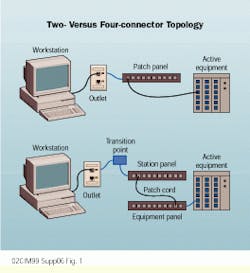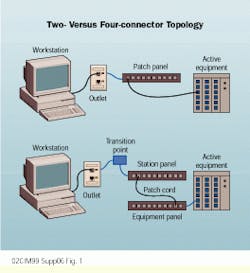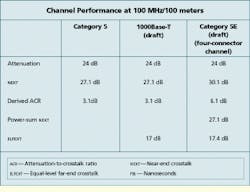Don`t pull out that Category 5 cabling, but do get your tester ready.
Tony E. Beam and Jerry Solomon / amp netconnect
It wasn`t that long ago that 10-megabit-per-second Ethernet was the fastest local area network (lan) in town. In just a few short years, lan speeds have grown to the point where 10-Mbit/sec shared Ethernet is the minimum available at most desktops, with many users migrating to switched 10-Mbit/sec and even shared and switched 100-Mbit/sec networks. This ever-increasing need for speed at the desktop translates into a need for similar increases in server connections and enterprise backbone networks. A 100-Mbit/sec Fiber Distributed Data Interface backbone that provided adequate support for several shared 10-Mbit/sec networks may become a serious bottleneck as those networks make the jump to switched 10- or 100-Mbit/sec transmission.
Gigabit Ethernet is the most logical next step in the evolution of these backbone networks and server connections. Gigabit Ethernet provides 1-gigabit-per-second data rates--10 times the rate of 100-Mbit/sec networks--while maintaining the same protocol, frame format, and frame size as existing 10- and 100-Mbit/sec Ethernet networks. Shipments of Gigabit Ethernet products are still in their infancy, with current sales approximately 200,000 ports per year, but shipments are expected to reach 7.8 million ports per year by 2001, according to the Dell`Oro Group (Portola Valley, CA).
lan speeds that were once considered sufficient for backbones eventually migrated to the desktop. This trend will likely continue and, sooner or later, we will see the need for gigabit transmission to the desktop. The emerging 1000Base-T standard is aimed at customers who want to upgrade to 1000-Mbit/sec (1-Gbit/sec) operation while using their existing Category 5 unshielded twisted-pair (utp) cabling infrastructure. But, there has been much concern, suspicion, and misinformation circulating in the market as to whether this type of upgrade will actually be possible. Although the 1000Base-T standard is not expected to be approved until mid-1999, the requirements for the cabling system necessary to run 1000Base-T appear to have been resolved and agreed upon.
Encoding schemes
The trick to running 1-Gbit/sec data on what has long been considered a 100-Mbit/sec cabling system has to do with the encoding schemes used by high-speed networks. The encoding scheme is the means that a particular network protocol uses to represent the data on the medium in question: copper, coaxial cable, or optical fiber.
Earlier networks, such as 10-Mbit/sec Ethernet and 4- and 16-Mbit/sec Token Ring, are based on a relatively inefficient encoding scheme that uses sequences of two different voltage levels to represent data on utp cabling. This scheme requires a cabling bandwidth essentially equal to (or a little in excess of) the data rate. For example, Category 3 cabling systems are specified through a bandwidth of 16 megahertz and are capable of supporting only a 10-Mbit/sec data rate with a two-level encoding scheme.
Starting with 100Base-T, we see a move toward more- sophisticated encoding schemes that allow us to get more "bang for the buck" from our cabling bandwidth. Instead of a two- level scheme, 100Base-T uses a multilevel transition encoding scheme, mlt-3, with three voltage levels to represent data. mlt-3 actually reduces the bandwidth required for 100-Mbit/sec transmission to approximately 62.5 MHz.
1000Base-T takes this scheme a step farther, using a five-level, pulse-amplitude-modulation encoding scheme known as pam-5. This scheme enables Gigabit Ethernet to transmit 250 Mbits/sec per pair over four pairs, in both directions simultaneously, for full-duplex operation at 1000 Mbits/sec, and all of this occurs within the 100-MHz bandwidth of Category 5. But there are prices to be paid for such sophistication. 10Base-T, 4- and 16-Mbit/sec Token Ring, and even 100Base-T lans use only two pairs out of a 4-pair cable for operation--one pair to transmit and one pair to receive. When we begin to use all four cable pairs in both directions simultaneously, new cabling performance parameters come into play that do not apply to 2-pair networks.
Draft 4.1 of the ieee 802.3ab standard for 1000Base-T states that the standard "provides support for 1000-Mbit/sec operation over four pairs of Category 5 or better balanced cabling." This has been the intent of the 802.3ab working group of the Institute of Electrical and Electronics Engineers (ieee--New York City) all along. But the group soon realized that they needed to know more about the performance of Category 5 cabling than was originally specified in the 1995 tia/eia-568a Commercial Building Telecommunications Cabling Standard of the Telecommunications Industry Association and the Electronic Industries Alliance (tia/eia--Arlington, VA). The ieee requested help from the tia, which will be forthcoming in the publication of telecommunications systems bulletin tsb-95, "Additional Transmission Performance Guidelines for 100-ohm 4-Pair Category 5 Cabling." tsb-95 will list the anticipated--but not required--performance characteristics of these additional parameters, which are not specified in tia/eia-568a: return loss, equal-level far-end crosstalk (elfext), power-sum elfext, and delay skew.
Category 5 or better?
Draft 4.1 states that "1000Base-T signaling requires four pairs of Category 5 cabling installed according to ansi/tia/eia-568a (1995) and tested for the additional performance parameters specified in 40.7 [these parameters are also specified in the tsb], using testing procedures defined in ansi/tia/eia-568a tsb-95." In essence, this statement requires the user to test with what is becoming known in the industry as a Level IIe tester--the tester that will be required to test for Enhanced Category 5 (Category 5E) performance. While the draft standard refers to Category 5, at the same time, it establishes these additional specifications that are not a part of the specifications for Category 5.
There is also an interesting statement in Annex A, "Additional Cabling Design Guidelines (Informative)," that deserves closer examination: "Cabling systems that meet or exceed the specifications in 40.7 for a worst-case four-connector topology are recommended for new installations." Let`s take a look at this in light of the emerging tia documentation.
The tia currently has two documents in process that concern 100-MHz cabling systems: PN-4292 (to be published as tsb-95) and sp-4195-a, the proposed Addendum No. 5 to tia/eia-568a. tsb-95 is intended to characterize, but not specify, additional parameters for existing Category 5 systems (see "Addendum or bulletin?", page 34). However, the introduction to the bulletin reads: "Although these are new guidelines, two-connector topologies compliant with tia/eia-568a are expected to meet these recommendations. Other topologies are supported as long as they meet the elfext and return-loss recommendations of this document." Two-connector topologies? A two-connector topology consists of the work-area outlet and a patch panel (or punchdown block).
The problem is that tia/eia-568a actually allows four connectors in a channel. These connectors are the work-area outlet, a transition point (originally defined as a transition between undercarpet cable and round cable, now also the consolidation point used for zone cabling), a station panel, and an equipment panel (or crossconnect). If we can`t be sure what kind of performance to expect from the simplest two-connector channels, what might we see in more-complex topologies? This leads us back to the ieee recommendation that new installations be provided with systems that can meet the 1000Base-T requirements even when using worst-case four-connector channels.
So what should I do?
It so happens that the Category 5E components and systems being defined by sp-4195-a provide just the right amount of performance headroom above the original Category 5 specifications to ensure compliance with 1000Base-T requirements when configured as a full-blown four-connector channel. In fact, the introduction to the addendum states: "The development of certain high-speed applications has brought to the attention of the tia the need for additional transmission requirements, such as multidisturber near-end crosstalk, return loss, and multidisturber far-end crosstalk. These parameters are needed by system designers for applications that utilize all four pairs in the cable for simultaneous bidirectional transmission." Sounds a lot like Gigabit Ethernet, doesn`t it? The nice thing, then, about Category 5E is that it allows us to design cabling systems that take full advantage of the topologies allowed by tia/eia-568a as well as the open-office topologies of tsb-75, while maintaining the high-performance characteristics demanded by 1000Base-T.
It becomes clear why some manufacturers are tying claims of Gigabit Ethernet support to the new Category 6/Level 7 products that are appearing on the market. While these products represent the next step in the evolution of twisted-pair cabling systems and offer increased operating margin for Gigabit Ethernet systems, in fact, the proposed 1000Base-T does not require 200-MHz Category 6 cabling system performance.
So, what will the introduction of 1000Base-T mean to the cabling industry? It won`t mean, as some have feared, that we will have to go back and pull out all of the Category 5 cabling installed over the last five or six years. But it does mean that existing installations will need to be retested to the new guidelines for return loss, elfext, and delay skew as set forth in tsb-95 and ieee 802.3ab to determine support for Gigabit Ethernet.
While many people have made claims as to how much of the installed base will meet or fail these new requirements, the real answer is that nobody knows. Category 5 products-- supplied by numerous manufacturers--have been installed by hundreds of contractors in thousands of installations for the last six years. Neither standards nor test procedures were in place during those installations, so it is impossible to make claims concerning the installed base. The only way to tell if installations meet the new requirements is to test.
Solutions
A number of actions could be attempted to bring a noncompliant system up to the new standards. The first and easiest possible solution would be to replace the work-area and equipment cords with higher-performance patch cords. If a crossconnect is used in the existing installed system, one should evaluate the possibility of switching to an interconnect solution. Lastly, the horizontal cabling could be reterminated with Category 5E outlet jacks and patch panels. Unfortunately, if the cabling system does not meet the 1000Base-T propagation delay or skew requirements, little alternative remains other than to pull new cables before moving to Gigabit Ethernet.
For new installations, Category 5E is the minimum recommended performance level. In fact, this recommendation appears in the ballot copy of the next revision of eia/tia-568. Pre-standard Category 6 cabling systems offer additional headroom and margin for Gigabit Ethernet as well as additional bandwidth for the development of future applications, but are not required for Gigabit Ethernet.
The ieee recommends that new Gigabit Ethernet installations meet worst-case requirements for four-connector channels (bottom).
Tony E. Beam is director of global systems marketing and Jerry Solomon is manager of copper systems marketing, both at amp netconnect (Winston-Salem, NC).


